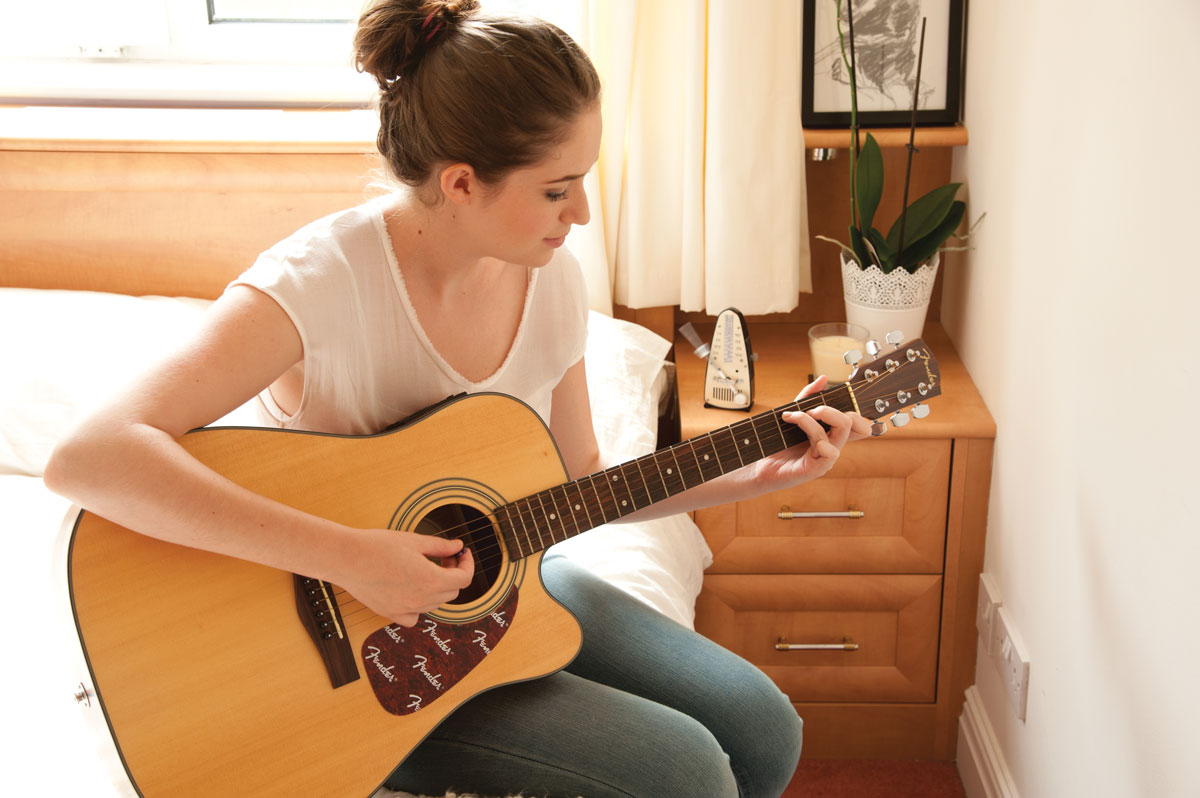How to lock into a groove as a guitarist
Achieve a masterful command over rhythm as a guitar player with these simple tips

There’s nothing better than playing guitar in front of a great rhythm section. Be it with backing tracks or other members of a live band, a fully locked-in rhythm can feel like a truly righteous experience.
Though being locked in isn’t exclusive to any one genre of music, the resurgent popularity of funk and soul-style guitar players on social media platforms like Instagram has put locked-in rhythm at the forefront of modern guitar playing trends.
But how do you actually lock in with your bandmates and what tools are needed to achieve this command over rhythm?
Get a reliable metronome

The first tool in any great player’s repertoire is a metronome. A metronome is either a physical or digital time-keeping/counting device that will play a tone or transient at a specific beat per measure. It’s essentially the most basic and perfect drummer you could ever imagine. The best part about using a metronome is there’s no need to rely on anyone else for your rhythmic needs; it’s just you and your metronome.
Any good metronome will feature the ability to customize multiple parameters within a desired beat. Such as: beats per measure, accent tones, beat tones, as well as selecting a time signature by selecting a specific amount of beats that play every measure.
A metronome-based warm up on your guitar each day will drastically improve your ability to lock-into a desired rhythm. Your routine can be as simple as strumming a chord or note on every other beat that the metronome plays or by playing your favorite scales to the beat you’ve programmed into the metronome.
More complex metronomes and metronome apps will allow for real-time speed increases, time signature subdivisions and custom beats per measure for plotting out rhythm drills or song structure for your own practice routines.
Doing any one of these during each day’s practice routine will elevate your rhythmic prowess substantially and quickly if you commit to it.
Play with a rhythm section

It can be easy to isolate yourself during times when you’re not totally adept at a certain musical skill. Being anxious about showcasing your guitar playing for fear of messing up can be paralyzing.
But nothing will increase your guitar playing ability more than simply playing with other musicians or musical backing tracks. And moreover, making mistakes in front of and with other players is one of the key learning experiences in any musician's life-long career.
Adapting to a song structure, bpm or just other people’s playing has a sort of “sink or swim” factor that can force your guitar playing mind into being comfortable within a vast number of situations.
Unfortunately, playing with other real humans can be hard or impossible at times. Luckily, modern-day solutions exist for this exact problem!
Many options for playing alone but with “others” include: finding guitar-less tracks on YouTube of your favorite songs or even jam sessions in specifics keys to follow along with, buying a drum machine to program beats or entire song structures into for playing along with, or building out songs within a DAW (Digital Audio Workstation) and adding in your guitar track for practice.
Record yourself learning and noodling

A major prerequisite of this step is having something to record your guitar with. The ability to record yourself playing guitar has become easier, more affordable and less CPU-intensive over the last 20 years or so.
Many modern guitar multi-effect pedals and amplifiers now include USB audio interfaces built-in or a reliable direct output for a line-level signal to be sent directly into your audio interface.
Or if all you have is a single 1/4” instrument cable input audio interface there are literally hundreds of powerful software amplifiers and DAW stock guitar processing plug-ins that will allow your guitar to sound great even without a real amplifier.
If you’re still sitting there without the ability to record your guitar after these options there’s a powerful device in your pocket that most definitely features some sort of audio recording ability, your phone! Even if you’ve got to utilize the Voice Memos app to track your guitar during practice, do it. Even Dave Grohl does this with new song ideas!
Recording yourself playing guitar is ideal for reflection and allows for note-taking on what’s giving you trouble. You can even combine steps like recording yourself playing with a metronome and seeing where you’re lagging, rushing or hitting the beat right on like a pro.
Simply pressing record with a metronome on and noodling around the fretboard will elevate your natural rhythm skill and might even help you discover the next great riff! Plus, while we’re on the topic of DAWs, every DAW known to humanity will include a metronome.
Learn to play drums

That’s right: learn to play the drums. This is a bit of an undertaking and an unorthodox step in your guitar playing career as drums are a completely different instrument from guitar – so, why would you take time to learn them?
The answer is: putting yourself in the rhythm section’s shoes, per se. When you’re behind the kit counting each beat and keeping time with the bass it makes you realize what’s important while leading rhythmically.
Sure, counting to 4 seems simple. But actively balancing that with multiple limbs playing different things, hitting each drum and cymbal as true as possible and following along with other rhythm parts makes feeling out the rhythm second-nature to you.
And that’s where you want to be: feeling the rhythm. After as little as a few months of practicing drums you’ll feel the change when you put on your guitar. Locking in with another drummer, metronome or backing track will feel second nature.
Locking into a rhythm section is easier said than done. But with a steady routine that prioritizes timing, rhythm and groove the results will be impossible to ignore. The influx of amazing players showcasing their talents isn’t that they’re naturally gifted, or because there’s something in the water.
True talent takes time, practice and a ton of passion, because getting through the tedious parts and playing the music you love makes it all worth it.
- Nicholas Wedyke is a writer for Guitar Tricks.
Get The Pick Newsletter
All the latest guitar news, interviews, lessons, reviews, deals and more, direct to your inbox!
“There are so many sounds to be discovered when you get away from using a pick”: Jared James Nichols shows you how to add “snap, crackle and pop” to your playing with banjo rolls and string snaps
Don't let chord inversions bamboozle you. It's simply the case of shuffling the notes around







![Joe Bonamassa [left] wears a deep blue suit and polka-dotted shirt and plays his green refin Strat; the late Irish blues legend Rory Gallagher [right] screams and inflicts some punishment on his heavily worn number one Stratocaster.](https://cdn.mos.cms.futurecdn.net/cw28h7UBcTVfTLs7p7eiLe.jpg)


